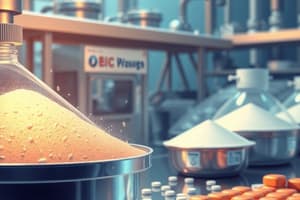Podcast
Questions and Answers
What is the maximum limit of poorly compressible ingredient allowed in direct compression for tablet manufacturing?
What is the maximum limit of poorly compressible ingredient allowed in direct compression for tablet manufacturing?
- 10%
- 30%
- 20% (correct)
- 40%
What is the main reason for choosing wet granulation over direct compression for tablet manufacturing?
What is the main reason for choosing wet granulation over direct compression for tablet manufacturing?
- Reduce tablet weight
- Improve flowability of the powder (correct)
- Increase the speed of manufacturing process
- Enhance tablet hardness
What are the main purposes of granulation?
What are the main purposes of granulation?
- To achieve flowability, compressibility, and prevent segregation (correct)
- To achieve flowability, prevent segregation, and improve dissolution
- To achieve flowability, improve dissolution, and prevent dustiness
- To achieve compressibility, prevent segregation, and improve stability
Which process is suitable for moisture-sensitive materials without the need for a drying step?
Which process is suitable for moisture-sensitive materials without the need for a drying step?
What determines the shape and dimension of a tablet?
What determines the shape and dimension of a tablet?
In which process are granules formed by compacting powders without added moisture?
In which process are granules formed by compacting powders without added moisture?
Which process is suitable for poorly compressible materials and those with poor flow properties?
Which process is suitable for poorly compressible materials and those with poor flow properties?
What is the main advantage of wet granulation over dry granulation?
What is the main advantage of wet granulation over dry granulation?
Which process creates granules by forming slugs and then milling them into smaller particles?
Which process creates granules by forming slugs and then milling them into smaller particles?
What is the main disadvantage of dry granulation?
What is the main disadvantage of dry granulation?
Which tabletting compaction process involves the reduction of bulk volume of powder in a die cavity under pressure?
Which tabletting compaction process involves the reduction of bulk volume of powder in a die cavity under pressure?
What is the main limitation of wet granulation?
What is the main limitation of wet granulation?
Which process is ideal for moisture-sensitive and heat-sensitive materials without the need for a drying step?
Which process is ideal for moisture-sensitive and heat-sensitive materials without the need for a drying step?
Flashcards
Direct compression limit
Direct compression limit
Maximum 20% of poorly compressible ingredient
Wet granulation advantage
Wet granulation advantage
To improve how easily the powder moves
Purposes of granulation
Purposes of granulation
Improve flow, compression, prevent separation
Moisture-sensitive process
Moisture-sensitive process
Signup and view all the flashcards
Tablet shape
Tablet shape
Signup and view all the flashcards
Compacting powders without moisture
Compacting powders without moisture
Signup and view all the flashcards
Poor flow/compressible materials
Poor flow/compressible materials
Signup and view all the flashcards
Advantage of wet over dry
Advantage of wet over dry
Signup and view all the flashcards
Slugs into particles
Slugs into particles
Signup and view all the flashcards
Disadvantage of dry
Disadvantage of dry
Signup and view all the flashcards
Tabletting: compression
Tabletting: compression
Signup and view all the flashcards
Wet granulation limit
Wet granulation limit
Signup and view all the flashcards
Ideal for moisture-sensitive and heat-sensitive
Ideal for moisture-sensitive and heat-sensitive
Signup and view all the flashcards
Study Notes
Tablet Manufacturing Processes
- Maximum limit of poorly compressible ingredient allowed in direct compression is 20-30%.
Choice of Granulation Process
- The main reason for choosing wet granulation over direct compression is to improve flow and compressibility of materials.
Purposes of Granulation
- The main purposes of granulation are to improve flow and compressibility of materials, and to reduce dust and segregation problems.
Suitable Processes for Moisture-Sensitive Materials
- Dry granulation is suitable for moisture-sensitive materials without the need for a drying step.
Tablet Shape and Dimension
- The shape and dimension of a tablet are determined by the die shape and punch configuration.
Slugging Process
- Slugging is a process where granules are formed by compacting powders without added moisture.
Suitable Processes for Poorly Compressible Materials
- Wet granulation is suitable for poorly compressible materials and those with poor flow properties.
Advantages of Wet Granulation
- The main advantage of wet granulation over dry granulation is that it provides better binding properties.
Dry Granulation Process
- Dry granulation creates granules by forming slugs and then milling them into smaller particles.
Disadvantages of Dry Granulation
- The main disadvantage of dry granulation is that it may not provide sufficient binding properties.
Tabletting Compaction Process
- The tabletting compaction process involves the reduction of bulk volume of powder in a die cavity under pressure.
Limitations of Wet Granulation
- The main limitation of wet granulation is that it requires a drying step, which can be time-consuming and affect the stability of some materials.
Ideal Process for Moisture-Sensitive Materials
- Dry granulation is ideal for moisture-sensitive and heat-sensitive materials without the need for a drying step.
Studying That Suits You
Use AI to generate personalized quizzes and flashcards to suit your learning preferences.




